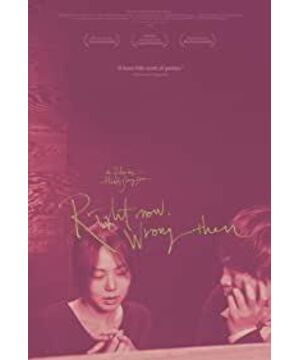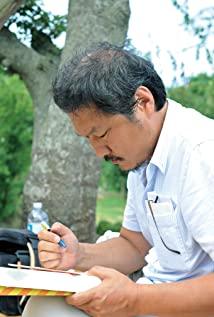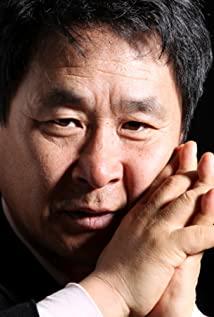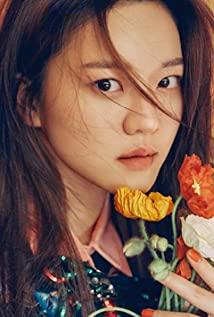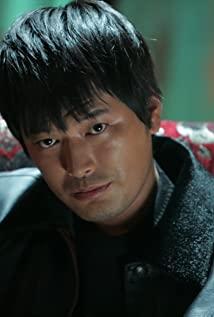Author: csh
This article first appeared in "Top Film"
Hong Changxiu's new work "The Woman Who Runs" has been screened at the Berlin Film Festival on February 25. In the released clip of this work, we can see three characters with umbrellas walking to a shed with their backs to us in a slow-moving long shot. The shot takes a broad, zig-zag path of motion, culminating in a distant landscape.
Such sports shots, in his previous works, can be said to be relatively rare. But fans who are familiar with him will notice something that hasn't changed - that is, the seemingly idle, but accurate scene scheduling.
Hong Changxiu has already become one of the most famous contemporary Korean directors with his twenty-three feature films. I think that every movie fan who loves casual daily life and delicate emotions will have a special liking for his works.
In addition to the uniqueness of the theme, the complex narrative structure and relatively unified audio-visual style also make his works highly recognizable: all his films are basically composed of mise-en-scene, medium-length long shots, and zoom. Narrative game propped up by push shots and clean sets.
In this audio-visual language system, mise-en-scene is an indispensable component. In his work sequence, scheduling is a routine technique. In every film, he will show at least one complicated in-depth scene scheduling, which usually occurs in chat scenes or drinking scenes.
His masterful and delicate scheduling, combined with other audiovisual techniques, imparts profound meaning to the seemingly simple images. But to this day, his technique remains relatively ignored. This may also be related to the humble nature of scheduling itself.
It's easy to detect his complex narrative structure, but when he uses displacement, motion and gesture to function in a wine scene, few viewers are immediately aware of their Complexity, because they are so subtle and so fast.
The discussion of scheduling in this article may demystify this subtle skill.
1. Narrative of scheduling: Can medium and long shots also tell a good story?
In Hong Changxiu's works, narration—that is, to promote the progress of narrative—is one of the most basic and important functions of film scheduling.
The way the scheduling achieves this is closely linked to Hong Changxiu's preference for medium shots and long shots. He often uses long-duration, often fixed-camera shots. His "Men's Future is a Woman" (2004) has an average shot length of nearly 89 seconds, and "We Sun Hee" (2013) is 122 seconds.
Of course, he does not exclude sports shots, he will use sports shots or the zoom push lens he is good at to assist in scheduling. In addition, the medium shot is his preferred scene. He will frequently use the medium shot to present the encounters, dialogues and drinks between the characters. "We Sun Hee" is a film composed almost entirely of double medium shots. .
Shots of this length and size are interdependent with complex scheduling techniques. The style of these shots is obviously completely different from the Hollywood-style coherent editing system. Hong Sang-soo is unable to move the narrative fluidly with close-ups, front-to-back shots, and eye-matching shots.
Of course, his films do not have the tight plots of Hollywood films, but he still needs the basic effects created by the above three methods: guiding the audience's attention, and highlighting the important information in the picture. At this time, scheduling becomes extremely powerful. arms.
In his pictures, the "movement state" of the characters, that is, the changes in position, posture, action and interrelationship, can provide a lot of narrative information. Under certain circumstances, scheduling can also turn the disadvantage of this type of shot into an advantage: the space for a medium shot can accommodate more content than a write-up shot, and Hong Changxiu can create a very layered image. narrative.
"Hae Won, Not Anyone's Daughter" (2013) has a drinking scene of more than nine minutes, one of the most complex sequences in Hong Sang-soo's film, and an example of the meticulous scheduling of medium shots.
In this film, college student Hae-won (played by Jung Eun-chae) and professor and director Sung-joon (played by Lee Sun-kyun) maintain a secret incestuous relationship. They ran into a group of classmates on the way, and after the professor asked Hae-won to keep a secret, the two joined those classmates' wine party.
In this scene, Hong Changxiu makes full use of the advantages of the medium shot. He does not need to deal with the relationship between characters and landscape like a fan of long shot scheduling (such as Angelopoulos), nor does he need to be like a director who is good at close-up. That way, only one or two characters can be dealt with. He can fill the whole picture with six or seven characters, guide the audience's focus through complicated scheduling, and determine the flow of the plot.
Overall, the basic way of scheduling in this scene is to create relative differences between different characters. From the construction stage of the scene, you can see Hong Changxiu's ingenuity. The whole picture adopts an asymmetric structure. Professor Chengjun in the foreground on the right occupies the largest space. His image is the closest and most complete to the audience, so he can always attract the attention of the audience.
The other characters in the frame (including male A in the foreground on the left) are far from the camera and are more or less obscured by the frame or other characters (Fig. 1), so they are in a secondary position in the frame . However, Hae-won, who was slightly obscured by male A, became the most important character in the picture by virtue of her unique movement state.
When Sung Joon greeted everyone to clink glasses for the first time, Hae Won was the only character who was completely blocked (Picture 2), but after everyone had a sip of wine, Hae Won was the last one to drink and the only one to drink up. people. When the professor talks to the male B in the background on the left, Hae-won's eyes are less intertwined with others, but she will briefly attract the audience's attention by pouring and drinking alone.
If Sung Joon is "present" and the other characters are "hidden", then Hae Won is the "hidden" character. In this way, Hong Changxiu creates three layers in a single picture: Sung Joon, the male protagonist, is the center of gravity of the picture for a long time; the surrounding classmates are the secondary characters against this center of gravity; in most cases, Hae-won is in a very hidden state, but she occasionally makes abrupt movements to steal our attention, and she is also the only character who leaves the scene halfway through.
Through this clear hierarchy, Hong Changxiu can help us clarify the main information and character relationships in the picture in the early stages of the scene without using editing and close-up shots.
However, the above-mentioned center of gravity and character relationship are not fixed, they only exist as a tone. They are constantly adjusted and changed to further the narrative. For example, a classmate who is speaking at the right moment will turn his face slightly towards the camera, briefly becoming the secondary focus of the frame, so that the audience can focus on the conversation between the professor and the classmate (Figure 3).
Towards the end of the scene, there is a scene where Sung Joon confronts Hae Won and drinks alcohol. At this time, Male A leaned back slightly, revealing most of Hae-won's body. Hae-won, whose face was tilted toward the camera, and Sung-joon, who was closest to the camera, became the two most conspicuous characters in the picture (Figure 4).
Hong Changxiu constructed a "pseudo-double shot" of Hae-won and Sung-joon by letting the surrounding characters recede into the background. Of course, unlike the double shot, this picture can accommodate more secondary characters, and the surrounding students who watch the two drinking have undoubtedly strengthened the awkward atmosphere in the entire shot.
2. The Expressiveness of Scheduling: The Art of Subtle Emotions
In Hong Changxiu's scene, the expressive function of scheduling is equally important. He can express the emotional state of the characters in the picture while promoting the narrative. We can also use the aforementioned wine scene to prove this point. Since Professor Chengjun is the main focus of this scene, the scheduling strategy of the whole scene is closely related to his emotional changes.
The looming Hae-won just shows the nervousness of Sung-joon trying to pay attention to Hae-won, but worrying about the discovery of his classmates. When Male A asked the professor if he liked Hae-won, Hong Changxiu further strengthened this scheduling technique: Male A kept leaning forward and leaning back, and we could only see Hae-won's expression intermittently. And when male A asked Chengjun "do you like me", the professor was relieved by the joke.
The teachers and students on both sides are smiling and leaning forward slightly, which establishes a balanced composition in the picture (Fig. 5), which also reflects Cheng Jun's emotional state from restlessness to temporary calm. But after everyone was talking and laughing and drinking, Hae-won suddenly got up and went to the toilet - the balance was broken again.
Then, the woman A on the right starts to talk with Sung Joon about the love relationship between Hae Won and Jae Woong (background on the right), the woman A who is facing the camera becomes the center of gravity in the picture, Sung Joon turns his head to look at her, this He turns his back to the camera, a rare moment in the scene where his focal position is replaced (Fig. 6).
This upsets the audience because Sung-joon's reaction is invisible at this point - but presumably Sung-joon is equally uneasy. However, as the conversation progressed, Sung Joon gradually realized that it turned out that everyone focused on Hae Won, not because they doubted their relationship with Hae Won, but because they both hated Hae Won. When this was confirmed, he laughed again, the figures on both sides formed a balanced symmetry again, and his mood was calm again (Figure 7).
However, when Hae-won returned, the off-screen tavern owner's recollection pointed to the fact that Sung-joon had been there with Hae-won a year earlier. Sung-joon's evasive remarks clearly upset Hae-won, so we see the confrontational drinking paragraph mentioned earlier. Then, Hae-won got up and was about to leave. For the first time in this scene, there was a moving shot. Hae-won, who was standing tall on the left, and the heads of the teachers and students on the right, created the most unbalanced composition so far (Fig. 8).
Then, the camera slowly moved back, and in the last picture of the scene, we saw the embarrassed expressions of everyone. Through scheduling, Hong Changxiu created the effect of imbalance-balance-re-imbalance-rebalance-final imbalance in this scene, thus showing Chengjun's emotional state of fluctuating between restlessness and calmness.
It can be seen that Hong Changxiu can promote the development of the plot and express the emotions of the characters by adjusting the relative differences in the movement states of the characters and the relative changes of such differences. This narration and representation method based on scheduling, although it has abandoned the strength and clarity of editing and close-up narration, it has also helped Hong Changxiu gain some unique advantages: fluency that is not interrupted by cutting, and secondary The resonance effect that exists between the character and the main character.
3. The structure of scheduling: the same scene, different scheduling
We have seen that Hong Changxiu combines scheduling with medium shots and long shots to create a film language system with unique narrative and ideographic effects. When the system is nested within his preferred narrative structure for interpreting specific themes, scheduling begins to be given more tasks.
Mark Raymond uses "forked narrative" to describe Hong Changxiu's usual narrative strategy. His concept is more general than most scholars' definitions, because the term can mean telling the same story in different ways, It can also refer to the practice of connecting with different narrative threads simultaneously in a linear narrative. In Hong Changxiu's early films (such as "The Power of Gangwon-do" [1998], "The Heart Sutra of the Virgin", etc.), we can see his preference for this narrative method.
The title of one of his masterpieces, Right Now, Wrong Then (2015), can accurately describe the effect achieved by this method: it repeats the same scene and designs some subtle differences to make the audience feel During the filming process, a series of delusions arise—“Did I remember it wrong then?” or “Would this be more appropriate?”—resulting in repeated reflections on the film’s plot.
This narrative method is closely related to the themes contained in Hong Changxiu's films. The themes he discusses seem to be loose, but they are actually relatively unified: almost all of his works describe the contradictory nature of daily life, which is both repetitive and impermanent. They are all thinking about the authenticity of memories, dreams and even images.
Hong Changxiu's audiovisual language system has an interdependent unity with his preferred structures and themes. Fewer, longer takes make the overall structure of the film appear clearer, and the unique narrative structure also prompts viewers to take a closer look at the information in the long takes.
From this point of view, the role of scheduling is also very important: on the one hand, it plays a structural function, helping the audience to realize the difference between different narrative contexts, so that the overall narrative structure can be established (rather than being reduced to simple repetition) ; on the other hand, it plays a thematic function, it creates a complex change within the concise lens, which has a thematic reference: under the seemingly mundane appearance, there is a certain impermanence and subtle meaning.
In "Right Now, Wrong Now", there are two drinking scenes with an average length of about ten minutes before and after, which can be used as wonderful cases for analyzing the structural and thematic functions of scheduling.
This film uses two different ways to portray the process of two encounters, acquaintances, and further development of relationship between director Han Qianxiu (played by Zheng Jae-young) and female artist Yoon Hee-jung (played by Kim Min-hee). In the first rendition, Chi-soo seemed more slick, praising Hee-jung's paintings and hiding his marriage -- but when this fact came to light, his relationship with Hee-jung broke down.
In the second rendition, Qianxiu became a more sincere man, and he began to point out the problems in the painting bluntly, and he also expressed his love to Xizheng and honestly spoke about his family situation.
In two different paragraphs, Hong Changxiu almost presented the same scene, Qianxiu and Xizheng also entered a tavern twice to drink and chat. This is an important node in the change of the relationship between the two. But through delicate scheduling, he makes the drinking scenes in different passages show subtle differences.
In the drinking scene of the first paragraph, the movement state of the two people seems to be more comfortable, and the range of movement also appears to be relatively large. Xizheng will naturally pick up the wet tissue on the table to wipe her hands, and will also stretch out her chopsticks to pick up dishes in the distance - her arms "cross" Qianxiu's body, in terms of form, this is a kind of The act of eliminating the sense of distance. This may be because Qianxiu in this paragraph is good at dealing with the relationship with women, and he has indeed just praised Xizheng's paintings.
Qianxiu is in a dominant position in this scene. He is facing the audience and is located in the geometric center of the picture, guiding the flow of the topic. And in the process of his speech, Hee-jung, who is basically facing the audience—both in terms of conversation and composition—plays a critical role (Fig. 9).
When she is looking forward to the director's answer to some important questions, she will even turn her back to the audience and face the director; and when the director is drunk or sweet, she will show more of her face in time for the audience to see her reaction. Towards the end of the scene, the director expresses his love to her and stares at her for a long time.
Hee-jung has her back to us all the time during this staring, and we can't see her reaction. Then, when the director was about to leave to smoke a cigarette, the primary and secondary relationship of the scene changed: when the director got up and left the audience with her back to the audience, she still showed most of her face to the audience, showing if she Thoughtful look (Fig. 10). As a result, her complex expression became the most important information in the picture at the moment.
On its own, it appears to be just an ordinary drinking and flirting scene. But if you compare it with the corresponding scene in the second paragraph, you can see the hidden mystery. In this passage, the sincere version of Qianxiu seems to make Xizheng feel a little uncomfortable, so in the drinking scene, the two appear to be more restrained at first. Hong Changxiu achieves this through more restrained scheduling: the scene of the scene It is farther than the first scene; the tissues are always neatly folded in front of Xi, and the dishes on the table are placed closer to her (compare picture 9 and picture 11), and she is not like the first scene. A natural pick-me-up action.
In addition, in the second scene, Qianxiu did not gain the control of the image, and the geometric center of the distant scene fell between the two, so they could each occupy half of the image (Figure 11). What's more, Hee Jung is always rocking the chair slightly in this scene, so for the most part, we can see her face.
Her movements and visible facial reactions allow her to always attract our attention at the same time as Qianxiu, who is facing the audience and leading the conversation. In this way, Hong Changxiu provides the audience with a more orderly and balanced visual experience at the beginning of the scene. Then, Qianxiu confessed to Xizheng again, but this time his tone was more sincere, and he also honestly confessed his family.
Then, the audience saw Qianxiu's long stare again, but this time Xizheng was half facing the camera, and her facial expression was always visible - in the sense of scheduling, this time she received more respect, Not reduced to a mere object of desire.
When the director began to cry and reveal his inner voice, Hee-jung began to turn his body frequently in his direction, and the initial visual balance of the scene was quietly broken. Unlike in the first scene, when the director gets up and leaves, Hee Jung keeps his back to the audience and stares at him (compare Figure 10 and Figure 12).
Many viewers will be aware of the differences in the character settings and dialogue texts of the two scenes, but what few people will notice is that Hong Changxiu has created a scene by adjusting the actor's position in the picture, the orientation of the body, and the range of movements. a deeper contrast.
Overall, Xizheng in the first scene went through a process of first facing the audience, facing the audience, and finally facing the audience. As the dialogue progressed, she gradually woke up from the state of being attached to Qianxiu; In the second scene, Xizheng first faced the audience and turned his back to the audience for a long time. She first maintained a certain distance from Qianxiu, but when he showed his sincerity, she also began to face the audience. Affection in the heart.
Structurally, Hong Changxiu not only created a superficial symmetry through the combination of repetitive narration and detail scheduling, but also presented a visual effect-level symmetry that subtly affects the audience.
Thematically, this butterfly effect rooted in the details just confirms the impermanence of life - any viewer who is aware of the changes in small details will immediately reflect on their connection to different story passages.
Hong Changxiu's exquisite scheduling techniques are an integral part of his works, and it works seamlessly with other audiovisual techniques to produce various effects.
Of course, the above discussion is only the basic function of scheduling. Hong Changxiu's works seem to have a highly similar style, but in fact each of his works is carrying out some kind of new experiment. In his creative career, he is also constantly exploring the artistic resources contained in film scheduling, making it collide with different audio-visual techniques and narrative forms.
In "We Shanxi", he used the scheduling in the double shot to the extreme; in "Before the Theater" (2005), he used scheduling to interpret the structure of "play within a play"; and in his recent "Riverside" In Hotel (2018), he tried to combine scheduling with big long shots and handheld shots.
There is no doubt that Hong Changxiu is a rare director who constantly explores the boundaries of his own style, and each of his new works deserves a wider and more detailed discussion. In "The Runaway Woman", what kind of technique does he collide with mise-en-scène? This is undoubtedly something to look forward to.
As David Bordwell puts it, the tradition of using scheduling "dries back to the enlightenment period of film history, but it is now gradually lost".
In this era when coherent editing is all the rage and the scheduling tradition is almost withered, Hong Changxiu still insists on embedding this film language in his own style, and still uses those masters of the silent film era-Louis Vuyard or Ye Fu Garney Bower - Techniques used.
Perhaps, the charm of Hong Changxiu's images lies not only in the languid daily life and leisure, but also in the film style that returns to the origin. When Jin Minxi walked alone on the seashore at night, she seemed to have stepped into the image of a hundred years ago.
View more about Right Now, Wrong Then reviews


